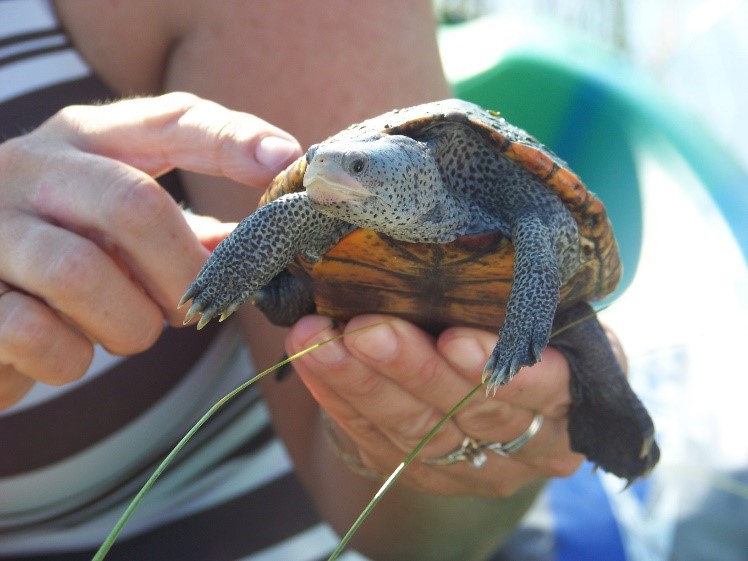
by Ray Bodrey | Apr 17, 2019
Soon, two important ecological surveys will begin in Gulf County, concerning both diamondback terrapins and mangroves.
Florida is home to five subspecies of diamondback terrapin, three of which occur exclusively in Florida. Diamondback terrapins live in coastal marshes, tidal creeks, mangroves, and other brackish or estuarine habitats. However, the diamondback terrapin is currently listed as a Species of Greatest Conservation Need (SGCN).
Diamondback terrapin populations, unfortunately, are nationally in decline. Human activities, such as pollution, land development and crabbing without by-catch reduction devices are often reasons for the decline, but decades ago they were almost hunted to extinction for their tasty meat. The recent decline has raised concern of not only federal agencies, but also organizations and community groups on the state and local levels. Diamondback Terrapin range is thought to have once been all of coastal Florida, including the Keys.
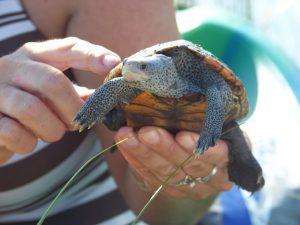
Figure 1: Diamondback Terrapin.
Credit: Rick O’Connor, UF/IFAS Extension & Florida Sea Grant, Escambia County.
Mangroves, a shoreline plant species of south Florida, are migrating north and are now being found in the Panhandle. Both red and black mangroves have been found in St. Joseph Bay. Mangroves establishment could be an important key to a healthy bay ecosystem, as a factor in shoreline restoration and critical aquatic life habitat.
Currently there is a significant data gap for both diamondback terrapin and mangrove populations. Therefore, there is a great need to conduct assessments to learn more about their geographic distribution.

Figure 2. Black Mangrove in St. Joseph Bay.
Credit: Ray Bodrey, UF/IFAS Extension & Florida Sea Grant, Gulf County.
The Forgotten Coast Sea Turtle Center is partnering with UF/IFAS Extension & Florida Sea Grant to assist in surveying and monitoring diamondback terrapins and mangroves in St. Joseph Bay, and we need your help! UF/IFAS Extension & Florida Sea Grant Agent’s Rick O’Connor and Ray Bodrey are providing a training workshop for volunteers and coordinating surveys for St. Joseph Bay. Terrapin surveys require visiting an estuarine location where terrapin nesting sites and mangrove plants are highly probable. Volunteers will visit their assigned locations at least once a week during the months of May and June and complete data sheets for each trip. Each survey takes about two hours, and some locations may require a kayak to reach.
If you are interested in volunteering for these important projects, we will hold a training session on Monday, April 22nd at 1:00 p.m. ET at the Forgotten Coast Sea Turtle Center (located at 1001 10th Street, Port St. Joe).
For more information, please contact:
Ray Bodrey, UF/IFAS Extension Gulf County, Extension Director
rbodrey@ufl.edu
(850) 639-3200
UF/IFAS Extension is an Equal Opportunity Institution.

by Rick O'Connor | Mar 29, 2019
We have a lot of really cool and interesting creatures that live in our bay, but one many may not know about is a small turtle known as a diamondback terrapin. Terrapins are usually associated with the Chesapeake Bay area, but actually they are found along the entire eastern and Gulf coast of the United States. It is the only resident turtle of brackish-estuarine environments, and they are really cool looking.
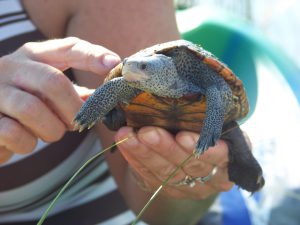
The diamond in the marsh. The diamondback terrapin.
Photo: Molly O’Connor
Terrapins are usually between five and 10 inches in length (this is the shell measurement) and have a grayish-white colored skin, as opposed to the dark green-black found on most small riverine turtles in Florida. The scutes (scales) of the shell are slightly raised and ridged to look like diamonds (hence their name). They are not migratory like sea turtles, but rather spend their entire lives in the marshes near where they were born. They meander around the shorelines and creeks of these habitats, sometimes venturing out into the seagrass beds, searching for shellfish – their favorite prey. Females do come up on beaches to lay their eggs but unlike sea turtles, they prefer to do this during daylight hours and usually close to high tide.
Most folks living here along the Gulf coast have not heard of this turtle, let alone seen one. They are very cryptic and difficult to find. Unlike sea turtles, we usually do not give them a second thought. However, they are one of the top predators in the marsh ecosystem and control plant grazing snails and small crabs. During the 19th century they were prized for their meat in the Chesapeake area. As commonly happens, we over harvested the animal and their numbers declined. As numbers declined the price went up and the popularity of the dish went down. There was an attempt to raise the turtles on farms here in the south for markets up north. One such farm was found at the lower end of Mobile Bay.
Early 20th century still found terrapin on some menus, but the popularity began to wane, and the farms slowly closed. Afterwards, the population terrapins began to rebound – that was until the development of the wire meshed crab trap. Developed for the commercial and recreational blue crab fishery, terrapins made a habitat of swimming into these traps, where they would drown. In the Chesapeake Bay area, the problem was so bad that excluder devices were developed and required on all crab traps. They are not required here in Florida, where the issue is not as bad, but we do have these excluders at the extension office if any crabber has been plagued with capturing terrapins. Studies conducted in New Jersey and Florida found these excluder devices were effective at keeping terrapins out of crab traps but did not affect the crab catch itself. Crabs can turn sideways and still enter the traps.

This orange plastic rectangle is a Bycatch Reduction Device (BRD) used to keep terrapins out of crab traps – but not crabs.
Photo: Rick O’Connor
Another 20th century issue has been nesting predation by raccoons. As we began to build roads and bridges to isolated marsh islands in our bays, we unknowingly provided a highway for these predators to reach the islands as well. On some islands, raccoons depredated 90% of the terrapin nests. Today, these turtles are protected in every state they inhabit except Florida. Though there is currently no protection for the terrapin itself in our state, they do fall under the general protection for all riverine turtles; you may only possess two at any time and may not possess their eggs.
Some scientists have discussed identifying terrapins as a sentinel species for the health of estuaries. Not having terrapin in the bay does not necessarily mean the bay is unhealthy, but the decline of this turtle (or the blue crab) could increase the population of smaller plant grazing invertebrates they eat throwing off the balance within the system.
Sea Grant trains local volunteers to survey for these creatures within our bay area. Trainings usually take place in April and surveys are conducted during May and June. This year we will be training volunteers in the Perdido area on April 10 at the Southwest Branch of the Pensacola Library on Gulf Beach Highway. That training will begin at 10:00 AM. For Pensacola Beach the training will be on April 15 at the Navarre Beach Sea Turtle Conservation Center on Navarre Beach. That training will begin at 9:00 AM. A third training will take place on April 22 at the Port St. Joe Sea Turtle Center in Port St. Joe. For more information on diamondback terrapins contact me at the Escambia County Extension Office – (850) 475-5230 ext. 111.
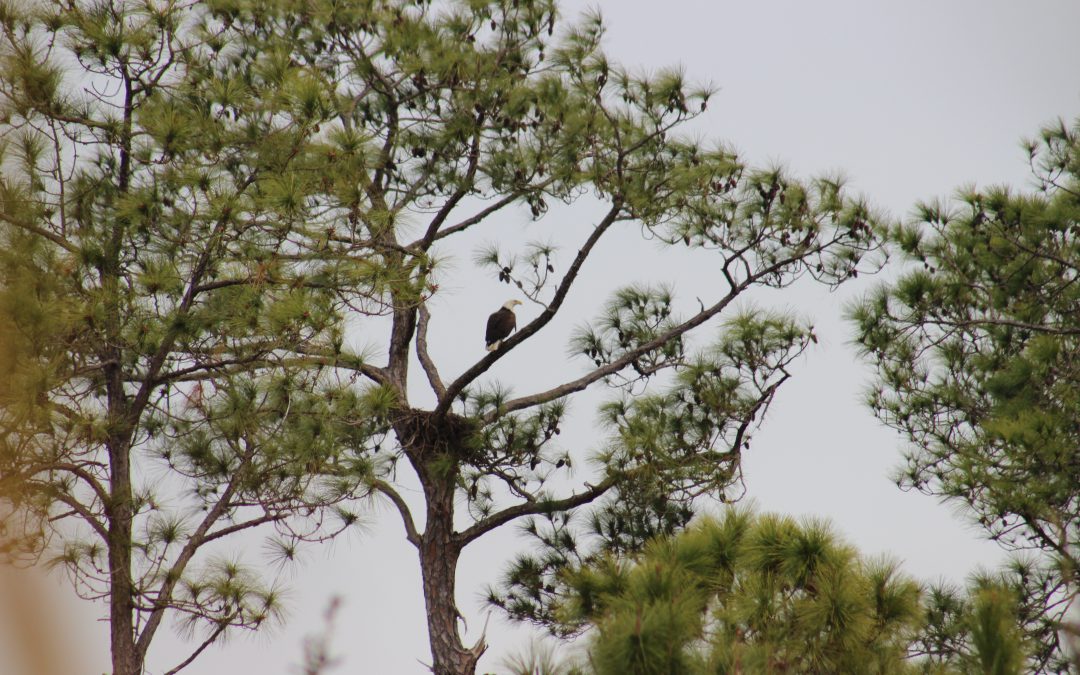
by Rick O'Connor | Feb 10, 2019
On a recent trip to Santa Rosa Island, my wife saw two bald eagles flying down the shore of Santa Rosa Sound. Wanting photos of the nest, we searched and found two individuals in a small nest (for an eagle) in a tall pine. One individual was an adult, the other a juvenile.
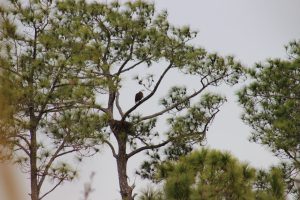
Bald eagle nest on Santa Rosa Island.
Photo: Molly O’Connor
Seeing bald eagles is like seeing bottlenose dolphins. I do not care how many times you have seen them over the course of your life, it is always exciting. Growing up here, I do not remember these animals in our area. Of course, their numbers suffered greatly during the DDT period, and poaching was (and still can be) a problem. But both the banning of DDT and the listing on the Endangered Species List did wonders for this majestic bird. They now estimate over 250,000 breeding populations in North America and 88% of those within the United States. Florida has some of the highest densities of nests in the lower 48 states. Though the bird is no longer listed as an endangered species, it is still protected by the Florida Eagle Rule, the federal Migratory Bird Treaty, and the federal Bald and Golden Eagle Protection Act.
It was shortly after Hurricane Ivan that someone told me they had seen a bald eagle in the area. My first reaction was “yea… right… bald eagle”. Then one afternoon on my back porch, my wife and I glanced up to see two flying over. Now we see them every year. The 2016 state report had 12 nesting pairs in the Pensacola Bay area. They were in the Perdido Bay area, Escambia Bay area, Holly-Navarre area, and Pensacola Beach area. Many locals now see these birds flying over our coastlines searching for food and nesting materials on a regular basis.
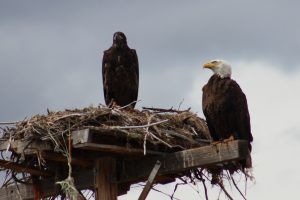
An adult and juvenile bald eagle on nest in Montana.
Photo: Molly O’Connor
Bald eagles are raptors with a thing for fish. However, they are opportunistic hunters feeding on amphibians, reptiles, crabs, small mammals, and other birds. They are also notorious “raiders” stealing fish from osprey, other raptors, and even mammals. They are also known scavengers feeding on carrion and visiting dumps looking for scraps. Benjamin Franklin was in favor of the turkey for our national emblem because the bald eagle was of such low moral character – referring their stealing and scavenging habit.
The Cornell Lab of Ornithology list the bald eagle as a year-round resident along the Gulf coast, but most of us see them in the cooler months. Their nesting period is from October through May. They select tall trees near water and build their nest just below the crown of the canopy. One local ecotourism operator has noticed their preference for live trees over the dead ones selected by osprey. Eagle nest are huge. A typical one will be 5-6 feet in diameter and 2-4 feet tall. The record was a nest found in St. Pete FL that was 10 feet in diameter and over 20 feet tall! The inside of the nest is lined with lichen, small sticks, and down feathers. One to three eggs are typically laid each season, and these take about 35 days to hatch. Both parents participate in nest building and raising of the young.
Viewing bald eagles is amazing, but approaching nests with eggs, or hatchlings, can be stressful for the parents. Hikers and motorized vehicles should stay 330 feet from the nests when viewing. Bring a distance lens for photos and be mindful of your presence.

An adult and juvenile bald eagle are perched in a dead tree near their nest.
Photo: Molly O’Connor
No matter how times you see these birds, it is still amazing. Enjoy them.
References
Florida Fish and Wildlife Conservation Commission. Bald Eagle Management. 2018. https://myfwc.com/wildlifehabitats/wildlife/bald-eagle/.
Jimbo Meador, personal communication. 2017.
Williams, K. 2017. All About Birds, the Bald Eagle. Cornell University Lab of Ornithology. https://www.allaboutbirds.org/guide/Bald_Eagle/overview.
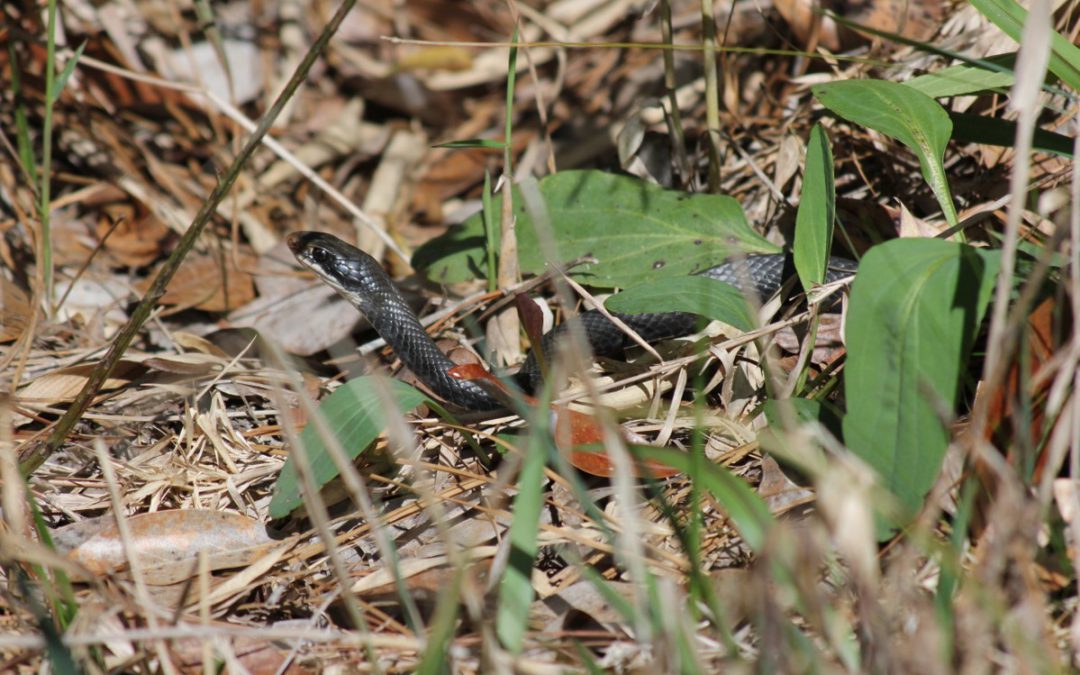
by Rick O'Connor | Jan 31, 2019
As we begin our wildlife series for 2019, we will start with a snake that almost everyone has encountered but knows little about – the southern black racer.
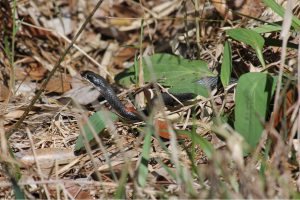
The southern black racer differs from other black snakes in its brilliant white chin and thin sleek body.
Photo: Jacqui Berger.
This snake is common for many reasons.
- It is found throughout the eastern United States
- It is diurnal, meaning active during daylight hours when we are out and about
- It can be found in a variety of habitats and is particularly fond of “edge” areas between forest and open habitat – they do very well around humans.
The southern black racer (Coluber constrictor priapus) is one of eight subspecies of this snake found in the United States. This local variety is a beautiful shiny black. The shine is due to the fact that they have smooth, rather than keeled, scales. It is a long snake, reaching up to six feet, but very thin – and very fast! Most of us see it just before it darts away.
They are sometimes confused with the cottonmouth. It can be distinguished in having a long “thin” body, as compared to the cottonmouths shorter “thick” body. It has a brilliant white chin and the top of the head is solid black. Cottonmouths can be mottled, usually have a cream-colored chin with a dark “mask” extending from the lower point of the chin through the eye. Cottonmouths also have the wide delta shaped head compared the finger-shaped head of the racer. They are also confused with the eastern indigo snake. The indigo is very long (up to eight feet) large bodied snake, and the lower chin is a reddish-orange color. The coachwhip is a close cousin of the racer, found in many of the same habitats. It has a similar body shape, and speed, but is a light tan color with a dark brown-black head and neck.

The juvenile black racer looks more like a corn snake, and is sometimes confused with a pygmy rattler.
Photo: C. Kelly
The juvenile looks nothing like the adult. The young racers hatch from rough covered eggs laid in late winter and early spring. They typically lay between 6-20 eggs and hide them under rocks, boards, bark, and even in openings in the side of homes. In late spring and early summer, they hatch. Their body resembles adults, but their coloration is a mottled mix of grays, browns, and reds – having distinct patches on their backs. This helps with camouflage but often they are mistaken for pygmy rattlesnakes and are killed.
They are great climbers and are found in our shrubs and trees, as well as on our houses and in our garages. Though sometimes confused with the cottonmouth, this snake is non-venomous and harmless. Harmless in the sense that a bite from will cause no harm – but it will bite. Black racers are notorious for this. If approached, it generally freezes first – to avoid detection. If it believes it has been detected, it will flee at amazing speeds. If it cannot flee, it will turn and bite… repeatedly. Again, the bites are harmless, but could draw blood. Cleaning with soap and water is all you need.
They are opportunistic feeders hunting a variety of prey including small mammals, reptiles, birds, insects, and eggs. They also hunt snakes, including small venomous species. Unlike the larger venomous snakes, black racers stalk their prey – many times with their heads raised similar to cobras. When prey is detected, they spring on them with lighting speed. Despite the scientific name “constrictor”, they do not constrict their prey, rather pin it down and wait for it to suffocate.
They do have their predators, particularly hawks. When approached they will first freeze to avoid detection, they may release a foul-smelling musk as a warning, and sometimes will vibrate their tails. In leaf-litter, this can sound very similar to a rattlesnake – not helping with the juvenile identification confusion. One paper reported finding a dead great horned owl with a black racer in its talons. Apparently, the owl grabbed the snake too far back. It killed the snake but not before the snake was able to strangle the owl.
They are hibernating this time of year but will soon be laying another clutch of eggs and we will once again encounter this most common of snakes.
References
Florida Museum of Natural History. Southern Black Racer (Coluber constrictor priapus). http://www.floridamuseum.ufl.edu/herpetology/fl-snakes/list/coluber-constrictor-priapus/.
Gibbons, W., M/ Dorcas. 2005. Snakes of the Southeast. University of Georgia Press, Athens GA. pp. 253.
Perry, R.W., R.E. Brown, D.C. Rudolph. 2001. Mutual Mortality of a Great Horned Owl and a Southern Black Racer: a Potential Risk for Raptors Preying on Snakes. The Willson Bulletin, 113(3). http://doi.org/10.1676/0043-5643(2001)113[0345:MMOGH0]2.0.CO;2.
Willson, J.D. Species Profile: Black Racer (Coluber constrictor priapus). SREL Herpetology. www.srelherp.uga.edu/snakes/colcon.htm.

by Rick O'Connor | Jan 18, 2019
Those of us who enjoy wildlife viewing do not see much this time of year. The days are shorter and colder. Most creatures have left or are hiding from the winter air. We grew up learning about hibernation and winter life for animals. But why do they do this? And are all of them doing so?
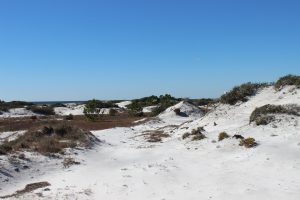
The spectacular dunes of south Walton County.
It is all about temperature. Our bodies have an internal temperature that must remain within a specific range for us to survive. Some creatures can survive at much higher temperatures than others, such as the desert pupfish. This fish lives in pools out west where water temperatures average 93°F. Others can live in very low temps, such as the Antarctic icefish – who live in water in the 28°F range. But most live with body temperatures in the 85-95°F, and most prefer to keep their body temperatures near the upper limit of their tolerance range.
How do they do this when it is cold outside?
Well, the can absorb heat externally – from the sun, the ground, being in contact with warm solid objects, and even from the air. For some creatures, this is their primary method of absorbing heat. We call them “ectotherms” – or “cold blooded”. These “cold bloods” have low metabolism, so they do not generate enough internal heat to help. Many also have an outer covering (scales) that is not a good insulator, so they cannot hold on to the heat they do produce. Most “cold bloods” are no where to be found this time of year. It is far too cold outside. Their food (the source for internal metabolic heat) is nowhere to be found either. Some of the “cold bloods” will find a burrow, or some location out of the elements and go into torpor (sleep). Torpor will allow them to slow their metabolism, which is going to happen anyway, to where their heart and respiration rates drop dramatically. This reduces the chance of losing more heat during breathing (which happens) and the low metabolism allows them to survive on stored energy until spring.
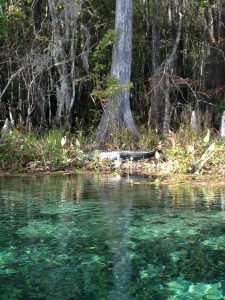
An alligator at Wakulla Springs taking advantage of the sun to bask and maintain body temperature. Photo credit: Carrie Stevenson
There are different levels of torpor. Some “cold bloods” are in DEEP torpor (true hibernation) and are basically unresponsive to external stimuli. Others are not so “deep” and may move around during winter. Snakes may emerge on warm sunny days in January to bask near the burrow entrance and regain some heat. Other “cold bloods” may just pack up and move – migrate – where it is warmer. This happens more with fish than reptiles and amphibians.
Then there are the endotherms, or “warm bloods”. These animals can maintain a relatively high body temperature this time of year and remain active – even seek out and hunt hibernating creatures. How do they do this?
First, they have a higher metabolism rate than “cold bloods”, and thus generate more internal heat. There is a cost for this though – 80-90% of the food they consume goes to maintaining their body temperature (and I say they… that would be WE…). This means “warm bloods” must eat more often and this can be problematic in winter when your favorite prey is in hibernation or has migrated.
In addition to producing more heat, their body covering (fur or feathers) helps insulate them so they do not lose the heat they have produced. “Fluffing” the fur or feathers helps some as well. There is a biological principal known as Bergmann’s Rule that states, “larger animals can maintain their body temperature better than smaller ones”. This has to do with surface area : volume ratios, and an article for another day, but let’s just say bigger animals can maintain a warmer body and remain more active. That said, smaller mammals (beach mice) may still need to hibernate or enter some form of torpor to survive this time of year.
One mammal that some folks on the beach still encounter this time of year is the coyote. One of the larger mammals in the beach ecosystem, and a top predator, coyotes are still active in winter. Actually, it is breeding time for them. The females usually find a denning spot as it becomes cold and gestation will last about 60 days; so, the pups will be here soon. The average number of pups / female is six; a pretty big family to feed honestly. At that point, in a few weeks, she will be seeking food to produce milk to nourish her pups – who will be sexually mature and ready to reproduce by Thanksgiving.
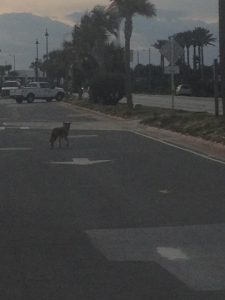
A coyote moving on Pensacola Beach near dawn.
Photo provided by Shelley Johnson.
Many who have encountered, and I spoke with one beach resident who recently saw one, are still nervous around them and not sure what to do. Despite the group calls (howls) they are famous for, they are not as social as wolves and can be seen alone. They have a natural fear of humans and try to avoid us. They are fantastic consumers of rodents (their favorite prey) and this sometimes brings them close to homes and businesses. They are more crepuscular (dawn and dusk) and nocturnal, so encounters are not common, but they happen. Usually when a coyote spots us, they freeze and then slide off into the night. This is good, and normal. Animals that stand their ground or approach humans can be a problem. They usually only do this when (a) they are sick and not acting normal, or (b) they have been fed by humans. This is not always intentional. Sometimes folks place their cat food outside for their cats and turn in for the night. If the coyotes find this, they will be back. In other cases, it has been intentional, and we strongly recommend you do not do this. In one study they found in Chicago, where coyotes do live but encounters are rare, their stomach content only had about 2% human food. Compare this with coyotes in southern California, where human food content is around 25% and negative human encounters are more common.
There is also concern about coyotes taking small pets. This happens. All predators are seeking prey that is easy to kill – where they can feed and not expend a lot of energy to make the kill. Small pets are easy to kill, larger than rodents, and carry more energy for them. It is recommended that you bring your small pets indoors during the evening.
In Escambia County, the County Extension office provides a monthly program called SCIENCE HOUR each month. Next month (February 7) the topic will be coyotes and pet safety. The presentation will be given by Elizabeth Heikkinen from FWC. We encourage all who have concerns about coyotes to come hear the talk and ask questions. Science Hour is held at the Escambia County Central Office Complex in Pensacola. 3346 West Park Place. We begin at 6:00 PM and it is free.
Though we see less wildlife this time of year, it is great time to walk the beaches. Get out and enjoy.

by Erik Lovestrand | Nov 26, 2018
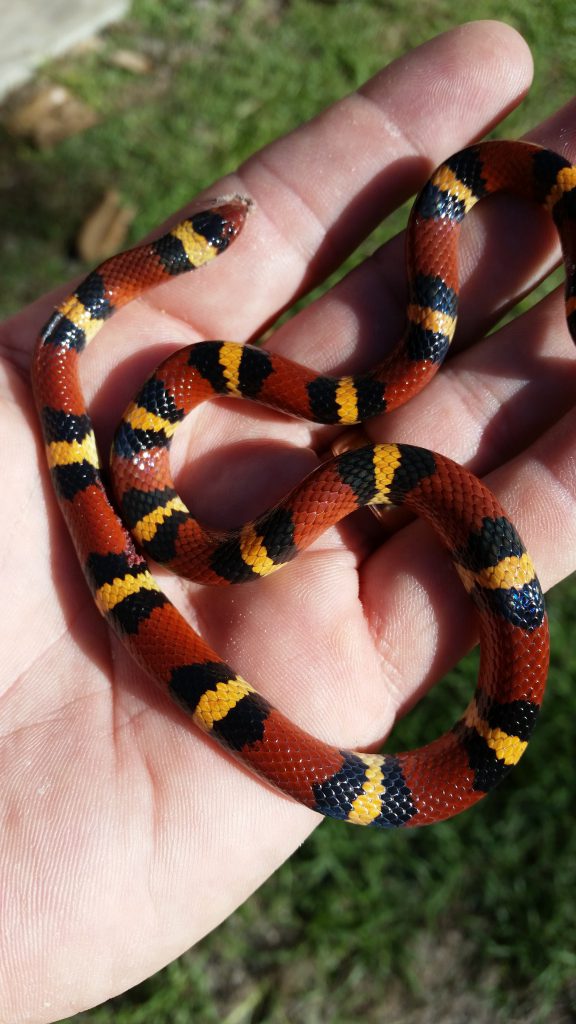
This beautiful scarlet kingsnake was run over near the author’s home
Snakes are some of the coolest animals on the planet but I’ll admit to something right up front; when a snake surprises me, I still jump, often. Even if I seem composed on the outside, something inside me almost always jumps. It does not matter if it is a venomous species or not. In spite of my basic understanding of and great appreciation for reptiles, snakes connect with a primal instinct that shouts “lookout” at some subconscious level. This human character trait is most-often the undoing of many an innocent serpent, happily going about its business when, WHAM, lights out. When a snake dares touch the human subconscious, our first emotion is often shock or fear; then perhaps anger; and in the end, payback for the offense. Many a good snake has met a very bad end when it has surprised a person.
Shock and fear are powerful emotions and I can almost (not totally) understand the outcome described above when someone is honestly shocked by a snake’s unexpected appearance. Nevertheless, even my wife, during a shocking encounter with a 5-foot oak snake while collecting eggs in the chicken house, was able gather her wits and shoo the critter out of the coop with a stick, rather than kill it. She did have me go the next evening to get the eggs though.
The one thing I have no empathy for however is when folks go out of their way to kill a snake that is trying to cross one of our roadways. About 90% of the dead snakes I see on the road are so close to the edge of the pavement that they were easily avoidable. C’mon people, that should be a “snake-safe” zone. These animals are likely never to encounter a human as they go about their business, performing important ecological functions in their natural habitat. Their great misfortune was that they had to cross an asphalt corridor used by humans. How about providing the same courtesy that most folks do when they see a turtle on the highway.
I see my share of cottonmouths smashed on the road (and that’s a shame too in my book) but other flattened species I’ve encountered include mud snakes, rat snakes, garter snakes, ribbon snakes, water snakes, racers, scarlet kingsnakes, green snakes, and many more; all harmless creatures. Recently, I stopped to look at a nice 4-foot coachwhip; a beautiful specimen, except for the fact that it was dead.
I get a thrill in seeing a living snake and having the chance to marvel at its form, function and beauty. If you ever have the chance to look closely at a pygmy rattlesnake in the wild (hopefully not in your turkey blind) you will be blown-away by its magnificent beauty. Black, velvety blotches on a gray background, with a rusty stripe running down the middle of its back. Same thing for a large diamondback rattlesnake (from a respectable distance). These have been some of my favorite natural encounters in the woods of North Florida, where we are truly blessed with a diversity of amazing animals and yes, super-amazing snakes. We should always use common sense of course when roaming the woods and enjoying our wild encounters, i.e. don’t ever catch venomous snakes (not worth the thrill), keep your hands out of hidden places, and watch where you put your feet. Oh, and work on cultivating a “live and let live” attitude when it comes to our scaly friends on the highway. They will oblige likewise.



















